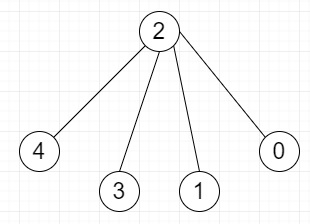
 Data Structure
Data Structure Networking
Networking RDBMS
RDBMS Operating System
Operating System Java
Java MS Excel
MS Excel iOS
iOS HTML
HTML CSS
CSS Android
Android Python
Python C Programming
C Programming C++
C++ C#
C# MongoDB
MongoDB MySQL
MySQL Javascript
Javascript PHP
PHP
- Selected Reading
- UPSC IAS Exams Notes
- Developer's Best Practices
- Questions and Answers
- Effective Resume Writing
- HR Interview Questions
- Computer Glossary
- Who is Who
Find if an undirected graph contains an independent set of a given size in Python
Suppose we have a given undirected graph; we have to check whether it contains an independent set of size l. If there is any independent set of size l then return Yes otherwise No.
We have to keep in mind that an independent set in a graph is defined as a set of vertices which are not directly connected to each other.
So, if the input is like L = 4,

then the output will be yes
To solve this, we will follow these steps −
Define a function is_valid() . This will take graph, arr
-
for i in range 0 to size of arr, do
-
for j in range i + 1 to size of arr, do
-
if graph[arr[i], arr[j]] is same as 1, then
return False
-
-
return True
Define a function solve() . This will take graph, arr, k, index, sol
-
if k is same as 0, then
-
if is_valid(graph, arr) is same as True, then
sol[0] := True
return
-
otherwise,
-
if index >= k, then
return(solve(graph, arr[from index 0 to end] concatenate a list with [index], k-1, index-1, sol) or solve(graph, arr[from index 0 to end], k, index-1, sol))
-
otherwise,
return solve(graph, arr[from index 0 to end] concatenate a list with [index], k-1, index-1, sol)
-
-
Example
Let us see the following implementation to get better understanding −
def is_valid(graph, arr):
for i in range(len(arr)):
for j in range(i + 1, len(arr)):
if graph[arr[i]][arr[j]] == 1:
return False
return True
def solve(graph, arr, k, index, sol):
if k == 0:
if is_valid(graph, arr) == True:
sol[0] = True
return
else:
if index >= k:
return (solve(graph, arr[:] + [index], k-1, index-1, sol) or solve(graph, arr[:], k, index-1, sol))
else:
return solve(graph, arr[:] + [index], k-1, index-1, sol)
graph = [
[1, 1, 0, 0, 0],
[1, 1, 1, 1, 1],
[0, 1, 1, 0, 0],
[0, 1, 0, 1, 0],
[0, 1, 0, 0, 1]]
k = 4
arr = []
sol = [False]
solve(graph, arr[:], k, len(graph)-1, sol)
if sol[0]:
print("Yes")
else:
print("No")
Input
[[1, 1, 0, 0, 0], [1, 1, 1, 1, 1], [0, 1, 1, 0, 0], [0, 1, 0, 1, 0], [0, 1, 0, 0, 1]], 4
Output
Yes

